Ultra-High-Performance Alkali-Activated Concrete: Effect of Waste Crumb Rubber Aggregate Proportions on Tensile and Flexural Properties
Abstract
:1. Introduction
2. Experimental Program
2.1. Materials
2.2. Testing Setup
2.2.1. Flowability Test
2.2.2. Axial Tensile Test
2.2.3. Flexural Test
2.2.4. SEM and EDS Analysis
3. Results
3.1. Micro Analysis
3.2. The Effect of Replacement Ratios of Crumb Rubber under Uniaxial Tensile Test
3.2.1. Damage Pattern
3.2.2. Tensile Stress–Strain Relationship
3.2.3. Tensile Strength and Toughness
3.2.4. Constitutive Model for Stress–Strain Relationship
3.3. The Effect of Crumb Rubber Replacement Ratios on Flexural Properties Testing
3.3.1. Failure Mode
3.3.2. Flexural Load–Deflection Relationship
3.3.3. Flexural Strength and Toughness
3.3.4. Equivalent Bending Strength
4. Conclusions
- (1)
- CR did not participate in the formation reaction of C-S-H in the alkali-activated material. It existed in T-UHPAC as a rough-surfaced aggregate. Though it would weaken the interfacial strength between aggregate and matrix because of the significant difference in elastic modulus, the particle size distribution of CR in relation to other materials and the dosage of CR should also be taken into consideration.
- (2)
- CR caused an air entrainment effect in the fresh mortar of T-UHPAC, generating defects at the material interface and reducing the tensile cracking strength. R-5 showed the highest tensile strength of 2.88 MPa. When the CR replacement ratio was 20% or below, the tensile toughness of T-UHPAC reached its highest value in this study, with only a 3% difference in tensile toughness values between R-0, R-5, and R-20.
- (3)
- Based on the concrete tensile constitutive model combined with the influence of CR on UHPAC’s tensile damage, a predictive model for the stress–strain curve of T-UHPAC considering the CR replacement ratio was proposed. The curve fitting performance improved with increasing CR replacement ratio, showing good predictive accuracy. The development of an effective constitutive model provides valuable support for the research and development of subsequent rubberized concrete performance.
- (4)
- T-UHPAC exhibited excellent flexural strength and toughness when the CR replacement ratio was not higher than 20%. Among them, R-20 had a flexural strength of 20.8 MPa and the highest equivalent flexural strength ratio, making it the best-performing group in terms of bending performance in this study. Based on the results of tensile tests, bending tests, and compressive strength, this study demonstrates that replacing quartz sand with up to 20% CR is suitable to enhance the tensile and flexural strength, as well as the toughness of T-UHPAC, while maintaining its compressive strength higher than 100 MPa. This provides theoretical support for the design and development of integrated utilization of recycled materials and low-carbon, environmentally friendly, ultra-high-performance building materials.
Author Contributions
Funding
Data Availability Statement
Conflicts of Interest
References
- Almutairi, A.; Tayeh, B.; Adesina, A.; Isleem, H.; Zeyad, A. Potential applications of geopolymer concrete in construction: A review. Case Stud. Constr. Mater. 2021, 15, e00733. [Google Scholar] [CrossRef]
- Chen, G.; Zheng, D.-P.; Chen, Y.-W.; Lin, J.-X.; Lao, W.-J.; Guo, Y.-C.; Chen, Z.-B.; Lan, X.-W. Development of high performance geopolymer concrete with waste rubber and recycle steel fiber: A study on compressive behavior, carbon emissions and economical performance. Constr. Build. Mater. 2023, 393, 131988. [Google Scholar] [CrossRef]
- Pan, H.; Xie, Z.; Chen, G.; Su, J.; Zhuo, K.; Chen, Z.; Lin, J.; Feng, C.; Guo, Y. Dynamic compressive behavior of high-strength engineered geopolymer composites. J. Build. Eng. 2023, 80, 108036. [Google Scholar] [CrossRef]
- Xiang, L.; Chen, G.; Pan, H.-S.; Wang, Y.-C.; Guo, Y.-C.; Jiang, Z.-X. Analysis of Stress-Strain Behavior in Engineered Geopolymer Composites Reinforced with Hybrid PE-PP Fibers: A Focus on Cracking Characteristics. Compos. Struct. 2023, 323, 117437. [Google Scholar] [CrossRef]
- Lin, J.-X.; Luo, R.-H.; Su, J.-Y.; Guo, Y.-C.; Chen, W.-S. Coarse synthetic fibers (PP and POM) as a replacement to steel fibers in UHPC: Tensile behavior, environmental and economic assessment. Constr. Build. Mater. 2024, 412, 134654. [Google Scholar] [CrossRef]
- Miri, M.; Ghasemi, M.R.; Nezhad, H.B. Experimental Investigation of Corrosion Cracking in Reinforced Concrete Beams Containing Nano Wollastonite. J. Rehabil. Civ. Eng. 2019, 7, 117–138. [Google Scholar]
- Arora, A.; Almujaddidi, A.; Kianmofrad, F.; Mobasher, B.; Neithalath, N. Material design of economical ultra-high performance concrete (UHPC) and evaluation of their properties. Cem. Concr. Compos. 2019, 104, 103346. [Google Scholar] [CrossRef]
- Dong, Y. Performance assessment and design of ultra-high performance concrete (UHPC) structures incorporating life-cycle cost and environmental impacts. Constr. Build. Mater. 2018, 167, 414–425. [Google Scholar] [CrossRef]
- He, Z.-H.; Han, X.-D.; Zhang, M.-Y.; Yuan, Q.; Shi, J.-Y.; Zhan, P. A novel development of green UHPC containing waste concrete powder derived from construction and demolition waste. Powder Technol. 2021, 398, 117075. [Google Scholar] [CrossRef]
- He, Z.-H.; Shen, M.-L.; Shi, J.-Y.; Yalçınkaya, Ç.; Du, S.-G.; Yuan, Q. Recycling coral waste into eco-friendly UHPC: Mechanical strength, microstructure, and environmental benefits. Sci. Total Environ. 2022, 836, 155424. [Google Scholar] [CrossRef]
- Lin, J.-X.; Su, J.-Y.; Pan, H.-S.; Peng, Y.-Q.; Guo, Y.-C.; Chen, W.-S.; Sun, X.-L.; Yuan, B.-X.; Liu, G.-T.; Lan, X.-W. Dynamic compression behavior of ultra-high performance concrete with hybrid polyoxymethylene fiber and steel fiber. J. Mater. Res. Technol. 2022, 20, 4473–4486. [Google Scholar] [CrossRef]
- Leila, K.; Kherraf, S.; Hebhoub, H.; Belachia, M. Performance of Concrete Containing Partial Granite and Tiling Wastes as Fine Aggregate. Civ. Environ. Eng. Rep. 2023, 33, 85–105. [Google Scholar] [CrossRef]
- Shahzad, K.; Zhao, Z. Experimental study of NaOH pretreated crumb rubber as substitute of fine aggregate in concrete. Constr. Build. Mater. 2022, 358, 129448. [Google Scholar] [CrossRef]
- Sofi, A. Effect of waste tyre rubber on mechanical and durability properties of concrete—A review. Ain Shams Eng. J. 2018, 9, 2691–2700. [Google Scholar] [CrossRef]
- Li, X.; Li, L.; Zheng, Y.; Li, Y.; Chen, Z.; Xiao, J.; Yuan, M.; Zhang, J.; Pan, Z.; Xiong, Z. A Study of the Compressive Behavior of Recycled Rubber Concrete Reinforced with Hybrid Fibers. Materials 2023, 16, 4731. [Google Scholar] [CrossRef] [PubMed]
- Shahjalal, M.; Islam, K.; Batool, F.; Tiznobaik, M.; Ahmed, K.; Alam, M.S.; Ahsan, R. Fiber-reinforced recycled aggregate concrete with crumb rubber: A state-of-the-art review. Constr. Build. Mater. 2023, 404, 133233. [Google Scholar] [CrossRef]
- Nadi, S.; Beheshti Nezhad, H.; Sadeghi, A. Experimental study on the durability and mechanical properties of concrete with crumb rubber. J. Build. Pathol. Rehabil. 2021, 7, 17. [Google Scholar] [CrossRef]
- Alsaif, A.; Alharbi, R. Strength, durability and shrinkage behaviours of steel fiber reinforced rubberized concrete. Constr. Build. Mater. 2022, 345, 128295. [Google Scholar] [CrossRef]
- Assaggaf, R.; Rizwan Ali, M.; Al-Dulaijan, S.; Maslehuddin, M. Properties of concrete with untreated and treated crumb rubber—A review. J. Mater. Res. Technol. 2021, 11, 1753–1798. [Google Scholar] [CrossRef]
- Wanasinghe, D.; Aslani, F.; Dai, K. Effect of age and waste crumb rubber aggregate proportions on flexural characteristics of self-compacting rubberized concrete. Struct. Concr. 2021, 23, 2041–2060. [Google Scholar] [CrossRef]
- Chrysanidis, T.; Panoskaltsis, V. Experimental investigation on cracking behavior of reinforced concrete tension ties. Case Stud. Constr. Mater. 2021, 16, e00810. [Google Scholar] [CrossRef]
- Hesami, S.; Hikouei, I.; Emadi, S. Mechanical behavior of self-compacting concrete pavements incorporating recycled tire rubber crumb and reinforced with polypropylene fiber. J. Clean. Prod. 2016, 133, 228–234. [Google Scholar] [CrossRef]
- Güneyisi, E. Properties of rubberized concretes containing silica fume. Cem. Concr. Res. 2004, 34, 2309–2317. [Google Scholar] [CrossRef]
- Alaloul, W.; Musarat, M.A.; Haruna, S.; Law, K.; Tayeh, B.; Rafiq, W.; Ayub, S. Mechanical Properties of Silica Fume Modified High-Volume Fly Ash Rubberized Self-Compacting Concrete. Sustainability 2021, 13, 5571. [Google Scholar] [CrossRef]
- Liu, Y.; Shi, C.; Zhang, Z.; Li, N.; Shi, D. Mechanical and fracture properties of ultra-high performance geopolymer concrete: Effects of steel fiber and silica fume. Cem. Concr. Compos. 2020, 112, 103665. [Google Scholar] [CrossRef]
- Wang, Y.; Chen, J.; Gao, D.; Huang, E. Mechanical Properties of Steel Fibers and Nanosilica Modified Crumb Rubber Concrete. Adv. Civ. Eng. 2018, 2018, 6715813. [Google Scholar] [CrossRef]
- Hossain, F.M.; Shahjalal, M.; Islam, K.; Tiznobaik, M.; Alam, M.S. Mechanical properties of recycled aggregate concrete containing crumb rubber and polypropylene fiber. Constr. Build. Mater. 2019, 225, 983–996. [Google Scholar] [CrossRef]
- Khoshroo, M.; Shirzadi Javid, A.A.; Bakhshandeh, N.; Shalchian, M. Investigation of the mechanical properties of concrete containing recycled aggregate and scrap crumb rubber and polypropylene fibers. Prog. Rubber Plast. Recycl. Technol. 2020, 37, 167–189. [Google Scholar] [CrossRef]
- Shahjalal, M.; Islam, K.; Rahman, J.; Ahmed, K.; Karim, M.; Billah, M. Flexural response of fiber reinforced concrete beams with waste tires rubber and recycled aggregate. J. Clean. Prod. 2021, 278, 123842. [Google Scholar] [CrossRef]
- Guo, Y.C.; Zhang, J.H.; Chen, G.; Chen, G.M.; Xie, Z.H. Fracture behaviors of a new steel fiber reinforced recycled aggregate concrete with crumb rubber. Constr. Build. Mater. 2014, 53, 32–39. [Google Scholar] [CrossRef]
- Aslani, F.; Khan, M. Properties of High-Performance Self-Compacting Rubberized Concrete Exposed to High Temperatures. J. Mater. Civ. Eng. 2019, 31, 04019040. [Google Scholar] [CrossRef]
- De Silva, P.; Sagoe-Crenstil, K.; Sirivivatnanon, V. Kinetics of Geopolymerization: Role of Al2O3 and SiO2. Cem. Concr. Res. 2007, 37, 512–518. [Google Scholar] [CrossRef]
- Van Deventer, J.; Provis, J.; Duxson, P.; Brice, D. Chemical Research and Climate Change as Drivers in the Commercial Adoption of Alkali Activated Materials. Waste Biomass Valoriz. 2010, 1, 145–155. [Google Scholar] [CrossRef]
- Chen, K.; Wu, D.; Xia, L.; Cai, Q.; Zhang, Z. Geopolymer concrete durability subjected to aggressive environments—A review of influence factors and comparison with ordinary Portland cement. Constr. Build. Mater. 2021, 279, 122496. [Google Scholar] [CrossRef]
- Gao, X.; Yu, Q.; Brouwers, H.J.H. Assessing the porosity and shrinkage of alkali activated slag-fly ash composites designed applying a packing model. Constr. Build. Mater. 2016, 119, 175–184. [Google Scholar] [CrossRef]
- Xie, J.H.; Wang, J.; Rao, R.; Wang, C.; Fang, C. Effects of combined usage of GGBS and fly ash on workability and mechanical properties of alkali activated geopolymer concrete with recycled aggregate. Compos. Part B Eng. 2018, 164, 179–190. [Google Scholar] [CrossRef]
- Lao, J.-C.; Xu, L.-Y.; Huang, B.-T.; Dai, J.-G.; Shah, S.P. Strain-hardening Ultra-High-Performance Geopolymer Concrete (UHPGC): Matrix design and effect of steel fibers. Compos. Commun. 2022, 30, 101081. [Google Scholar] [CrossRef]
- Wang, H.; Wu, Y.; Cheng, B. Mechanical properties of alkali-activated concrete containing crumb rubber particles. Case Stud. Constr. Mater. 2021, 16, e00803. [Google Scholar] [CrossRef]
- Ding, Y.; Shi, C.-J. Fracture properties of alkali-activated slag and ordinary Portland cement concrete and mortar. Constr. Build. Mater. 2018, 165, 310–320. [Google Scholar] [CrossRef]
- ASTM-C1437; Flow of Hydraulic Cement Mortar. ASTM International: West Conshohocken, PA, USA, 2013.
- T/CBMF 37-2018; Basic Performance and Test Methods of Ultra-High Performance Concrete. China Building Materials Council: Beijing, China, 2018.
- ASTM C1609-18; Standard Test Method for Flexural Performance of Fiber-Reinforced Concrete (Using Beam with Third-Point Loading). ASTM International: West Conshohocken, PA, USA, 2018.
- Liu, B.; Guo, J.; Wen, X.; Zhou, J.; Deng, Z. Study on flexural behavior of carbon fibers reinforced coral concrete using digital image correlation. Constr. Build. Mater. 2020, 242, 117968. [Google Scholar] [CrossRef]
- Liu, F.; Ding, W.; Qiao, Y. Experimental investigation on the flexural behavior of hybrid steel-PVA fiber reinforced concrete containing fly ash and slag powder. Constr. Build. Mater. 2019, 228, 116706. [Google Scholar] [CrossRef]
- Liu, R.; Li, H.; Jiang, Q.; Meng, X. Experimental investigation on flexural properties of directional steel fiber reinforced rubberized concrete. Structures 2020, 27, 1660–1669. [Google Scholar] [CrossRef]
- Yang, H.M.; Zhang, S.M.; Wang, L.; Chen, P.; Shao, D.K.; Tang, S.W.; Li, J.Z. High-ferrite Portland cement with slag: Hydration, microstructure, and resistance to sulfate attack at elevated temperature. Cem. Concr. Compos. 2022, 130, 104560. [Google Scholar] [CrossRef]
- Park, S.H.; Kim, D.J.; Ryu, G.S.; Koh, K.T. Tensile behavior of Ultra High Performance Hybrid Fiber Reinforced Concrete. Cem. Concr. Compos. 2012, 34, 172–184. [Google Scholar] [CrossRef]
- Sun, T.; Wang, X.; Maimaitituersun, N.; Dong, S.; Li, L.; Han, B. Synergistic effects of steel fibers and steel wires on uniaxial tensile mechanical and self-sensing properties of UHPC. Constr. Build. Mater. 2024, 416, 134991. [Google Scholar] [CrossRef]
- Tahwia, A.M.; Abd Ellatief, M.; Heneigel, A.M.; Abd Elrahman, M. Characteristics of eco-friendly ultra-high-performance geopolymer concrete incorporating waste materials. Ceram. Int. 2022, 48, 19662–19674. [Google Scholar] [CrossRef]
- Albidah, A.; Alsaif, A.; Abadel, A.; Abbas, H.; Al-Salloum, Y. Role of recycled vehicle tires quantity and size on the properties of metakaolin-based geopolymer rubberized concrete. J. Mater. Res. Technol. 2022, 18, 2593–2607. [Google Scholar] [CrossRef]
- Valizadeh, A.; Hamidi, F.; Aslani, F.; Shaikh, F.U.A. The effect of specimen geometry on the compressive and tensile strengths of self-compacting rubberised concrete containing waste rubber granules. Structures 2020, 27, 1646–1659. [Google Scholar] [CrossRef]
- Lei, D.-Y.; Guo, L.-P.; Li, Y.; Zheng, Z.; Liu, J.-P.; Li, S.-C.; Wang, P.-G.; Li, C.-C.; Mechtcherine, V.; Li, Z.-H.; et al. The investigating on mechanical properties of ultra-high strength and ultra-high ductility cementitious composites (UHS-UHDCC). J. Build. Eng. 2021, 43, 102486. [Google Scholar] [CrossRef]
- Su, J.-Y.; Chen, G.; Pan, H.-S.; Lin, J.-X.; Zhang, J.; Zhuo, K.-X.; Chen, Z.-B.; Guo, Y.-C. Rubber modified high strength-high ductility concrete: Effect of rubber replacement ratio and fiber length. Constr. Build. Mater. 2023, 404, 133243. [Google Scholar] [CrossRef]
- GB 50010-2010; Code for Design of Concrete Structures. Ministry of Housing and Urban-Rural Development: Beijing, China, 2010.
- Li, J.; Chen, J.; Wan, C.; Niu, J. Flexural toughness and evaluation method of steel fiber reinforced self-compacting lightweight aggregate concrete. Constr. Build. Mater. 2021, 277, 122297. [Google Scholar] [CrossRef]

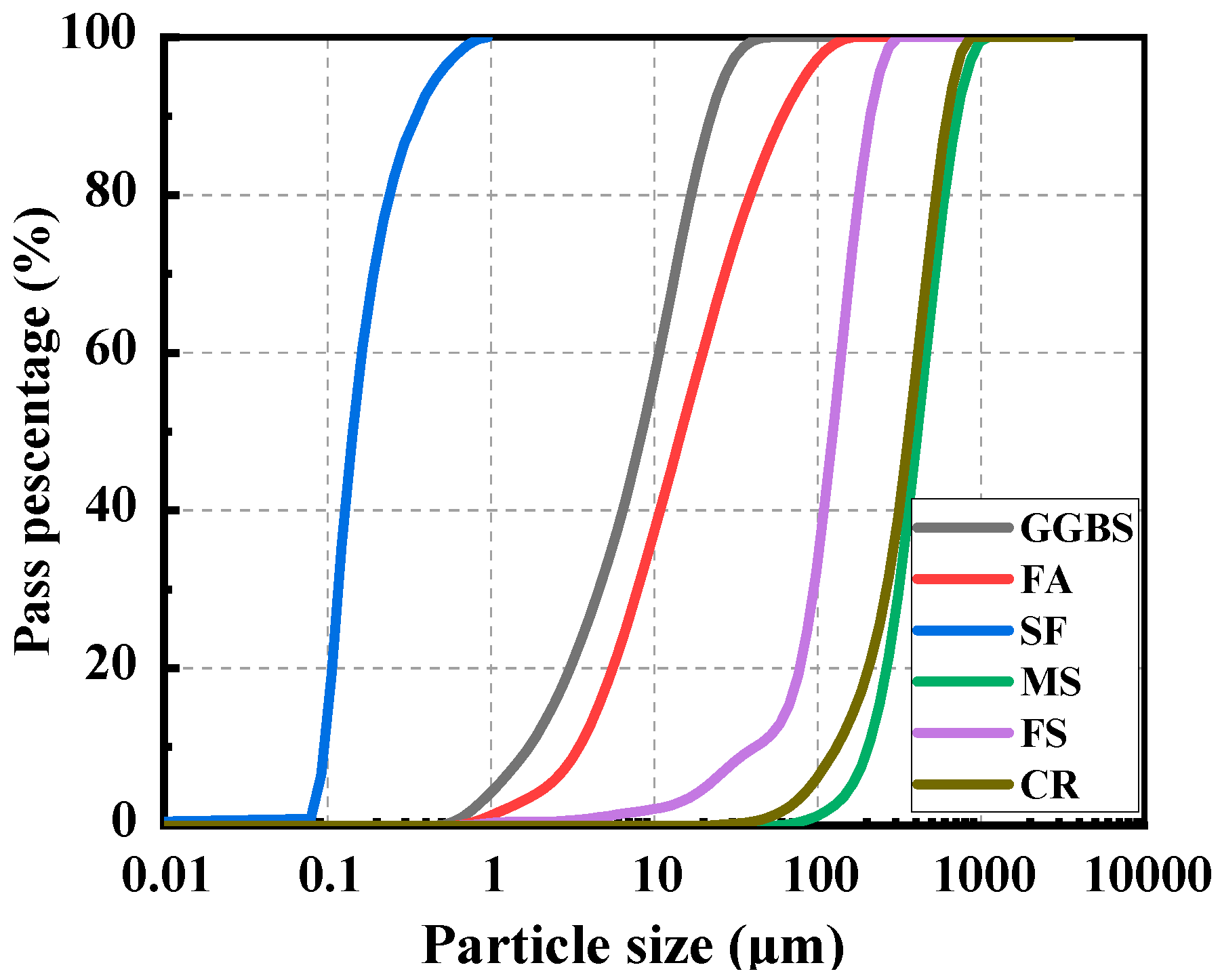
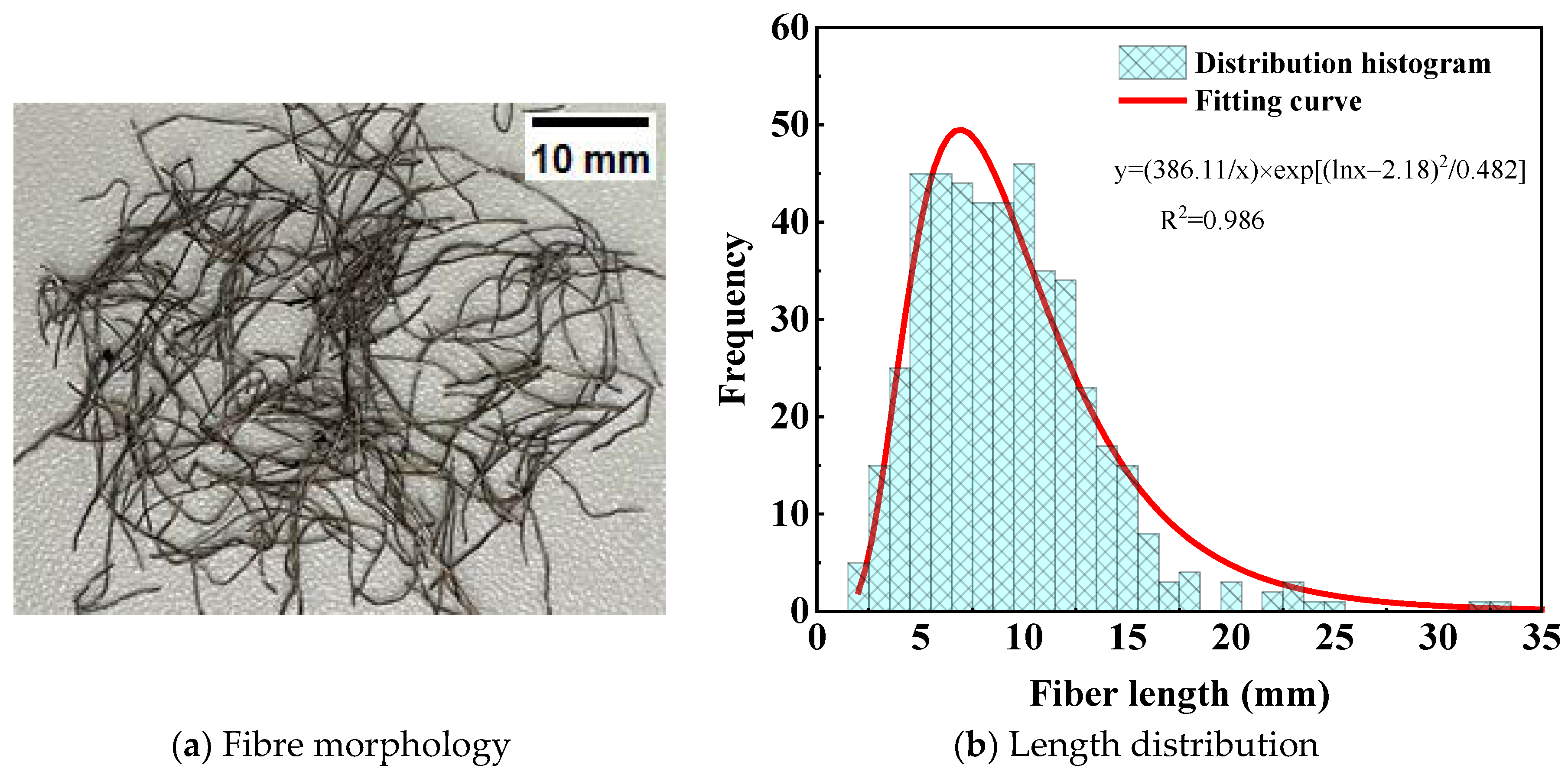

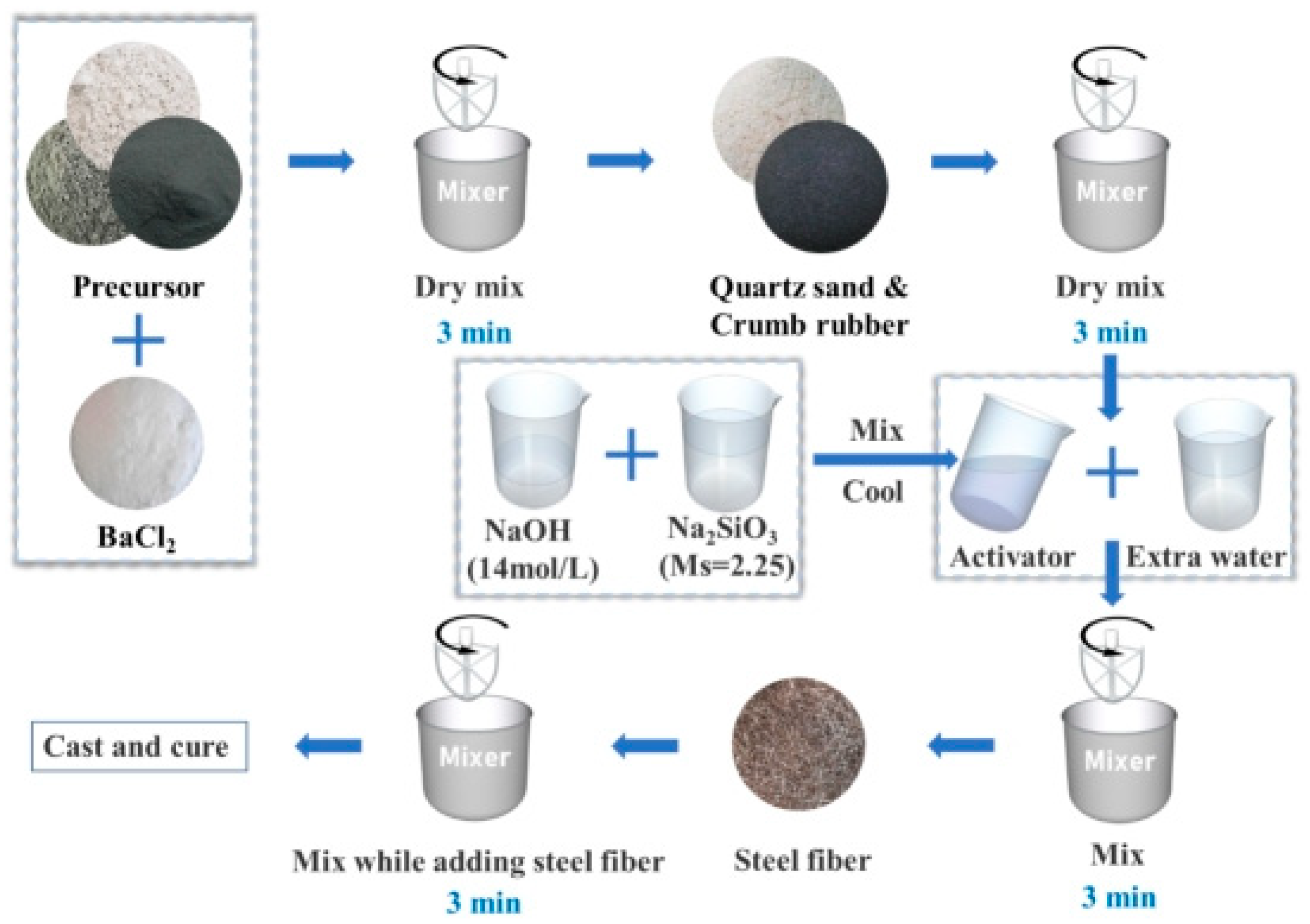
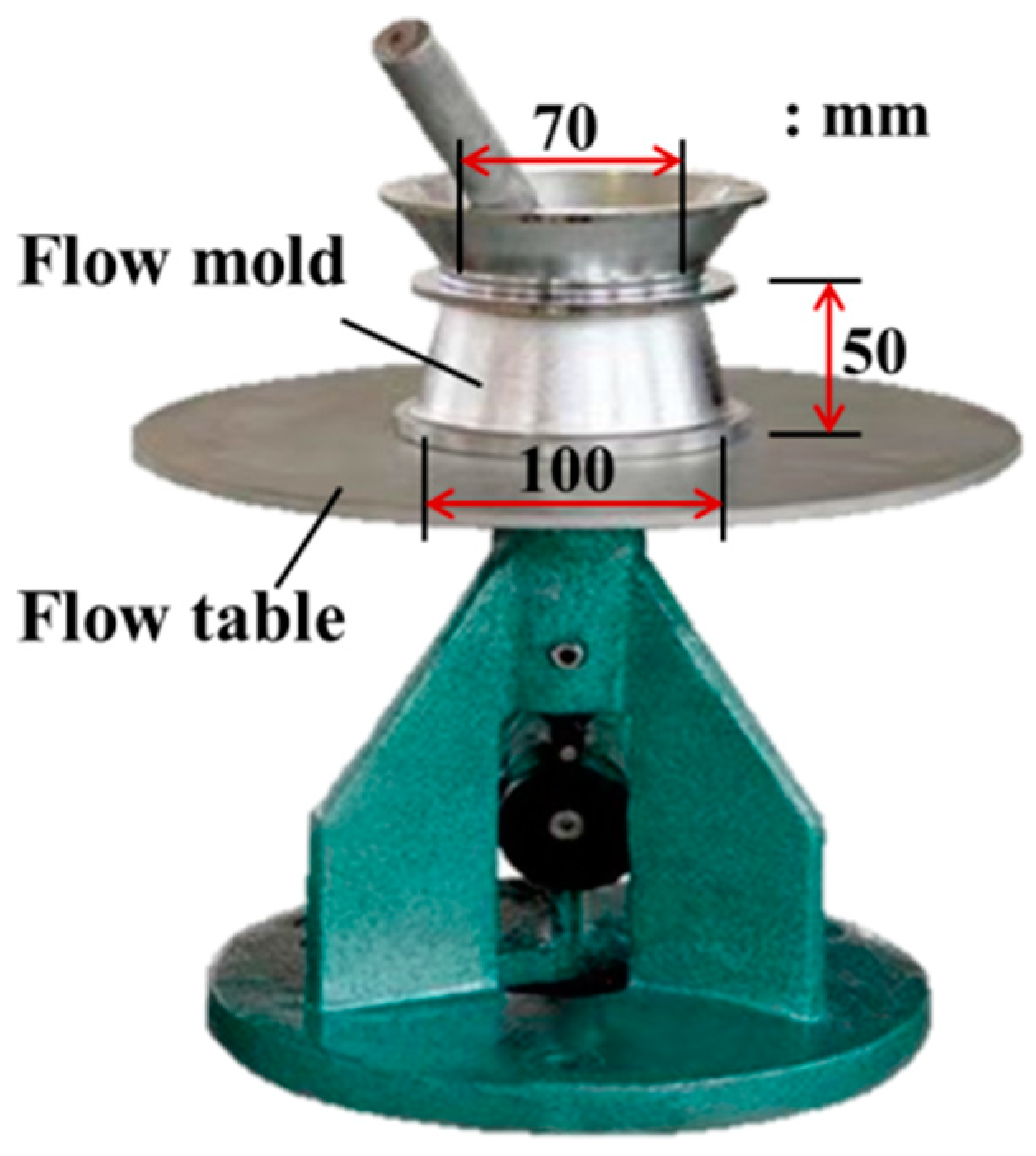

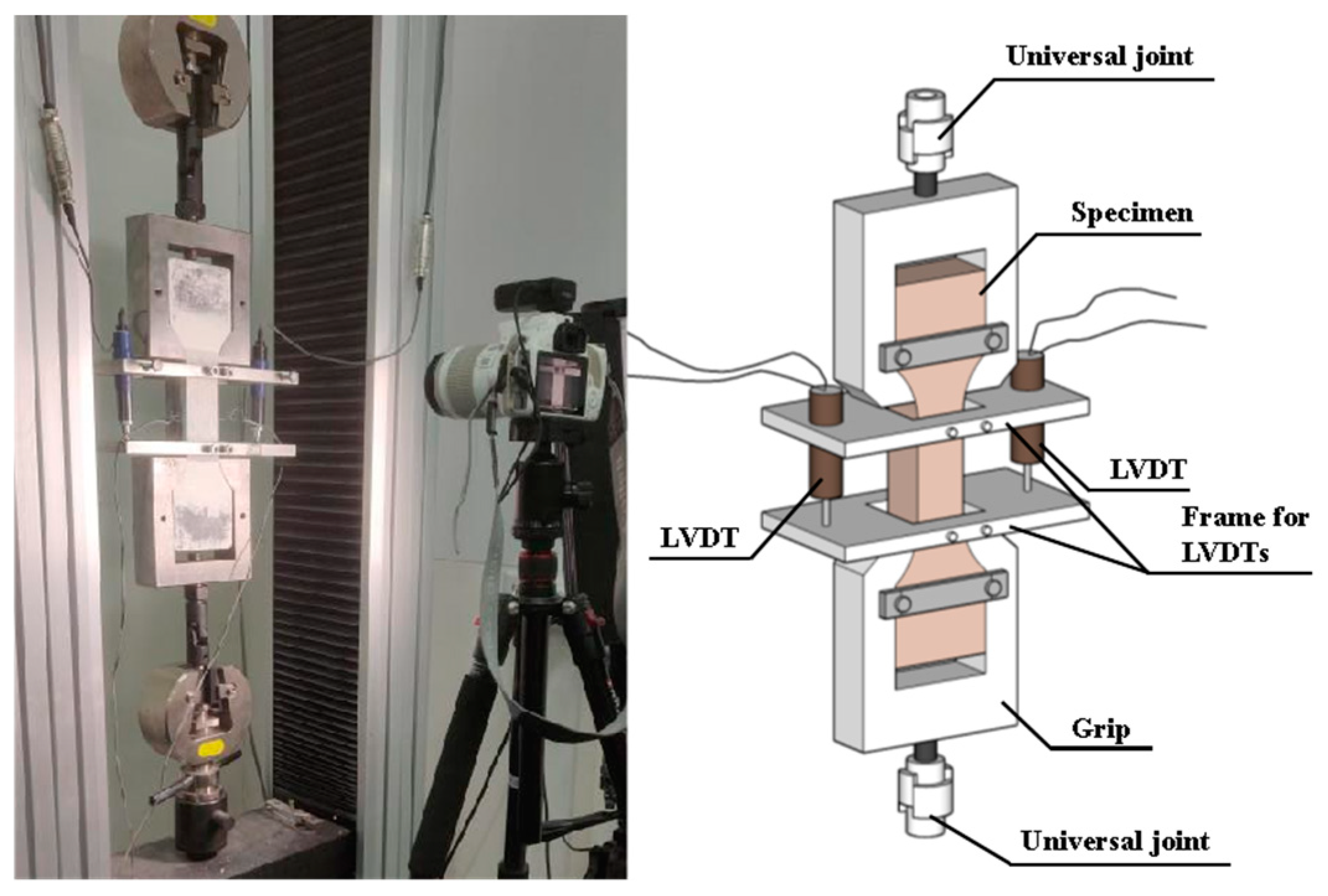
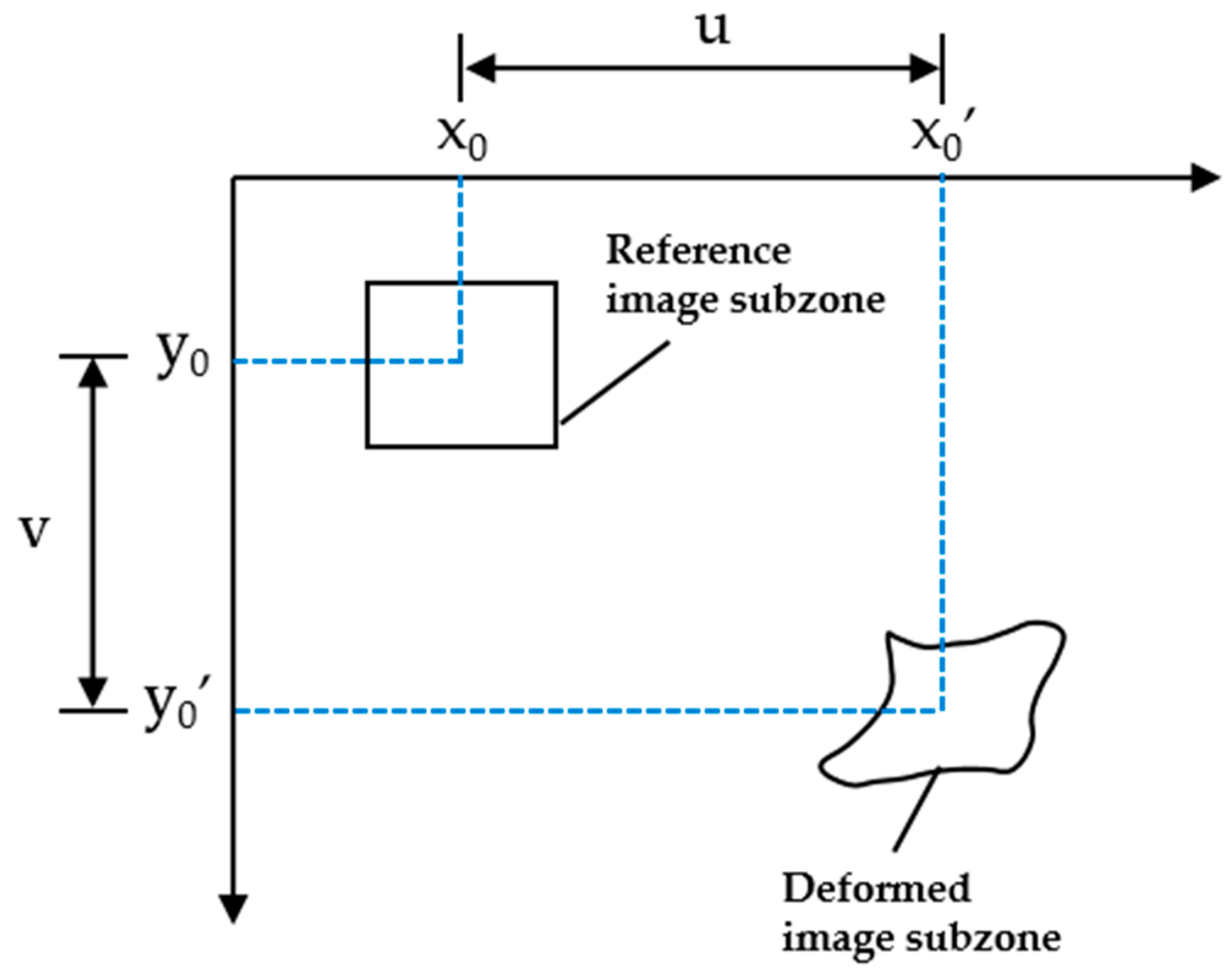
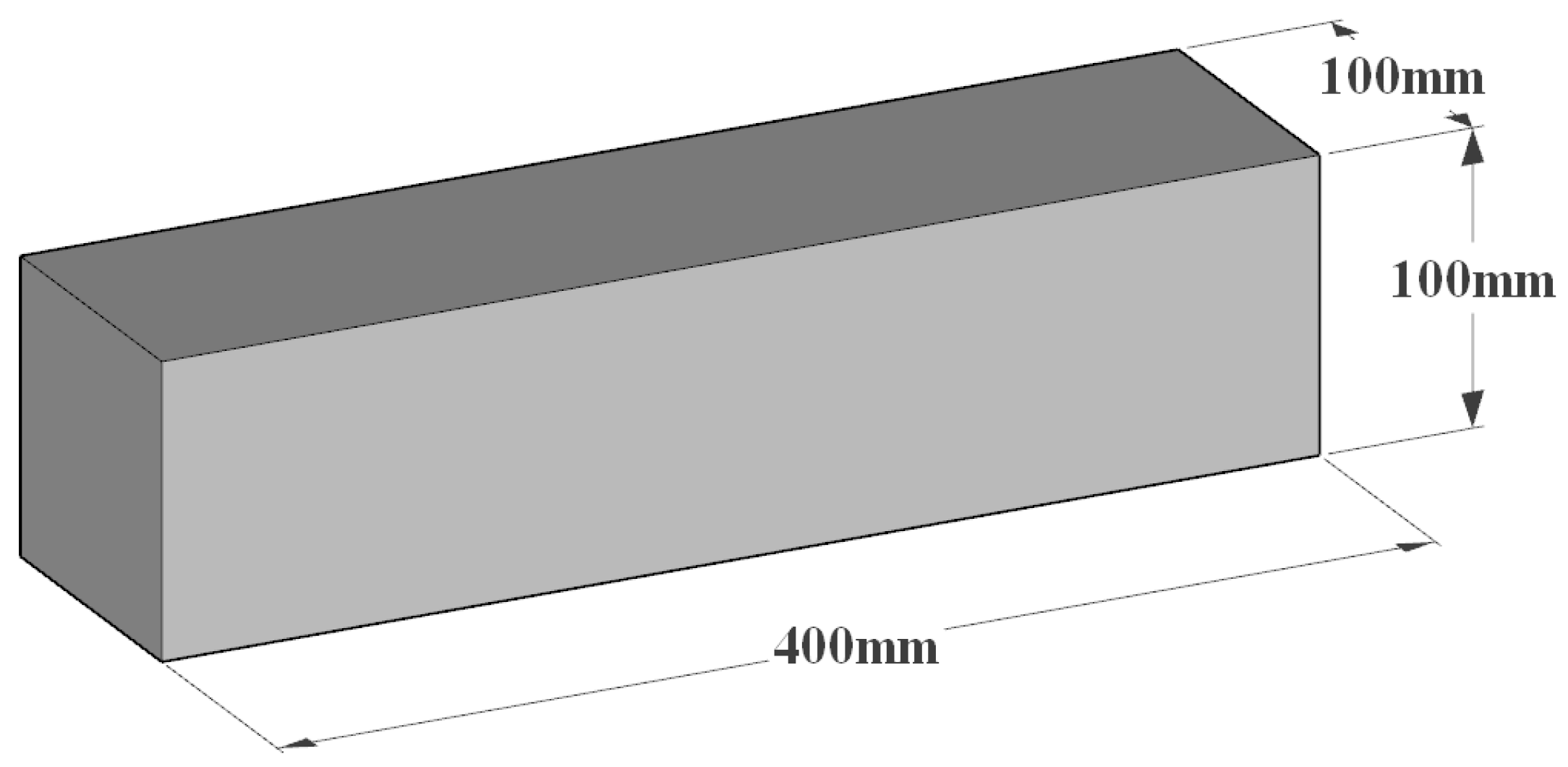
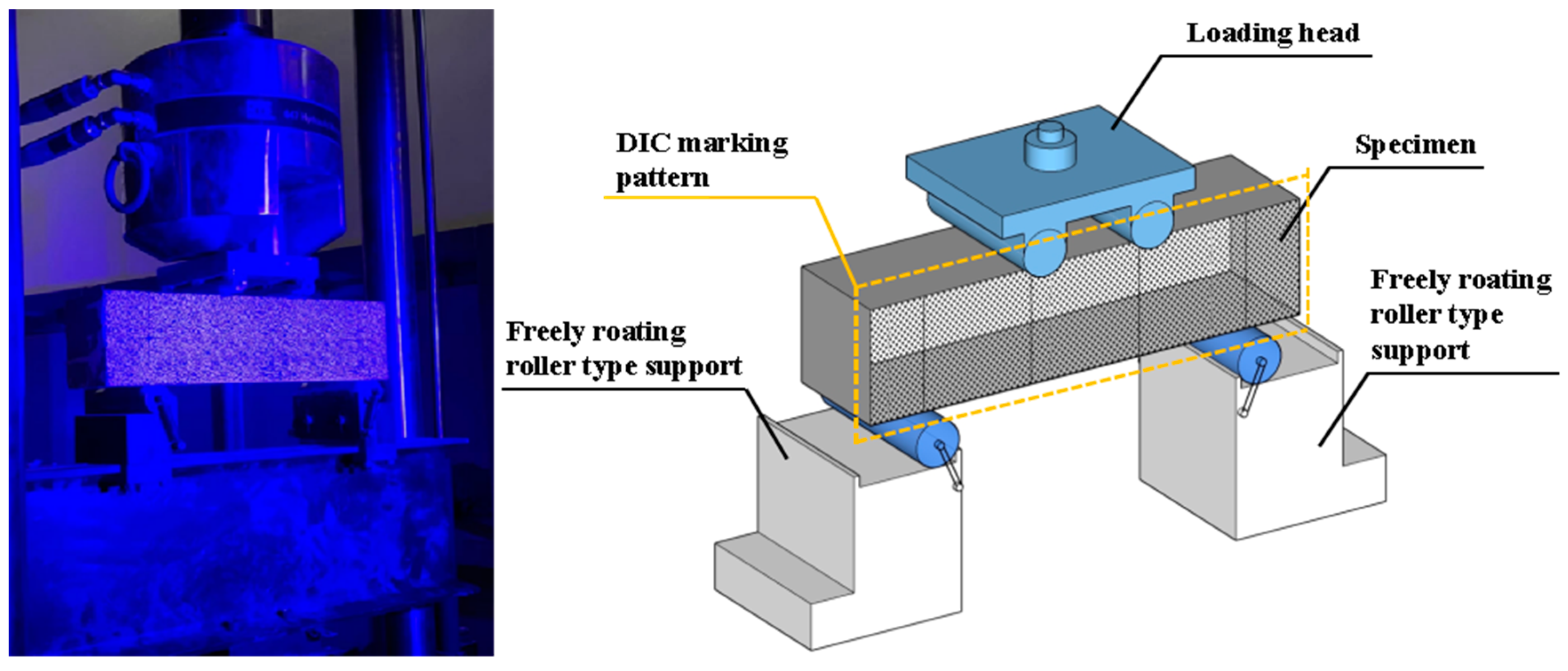
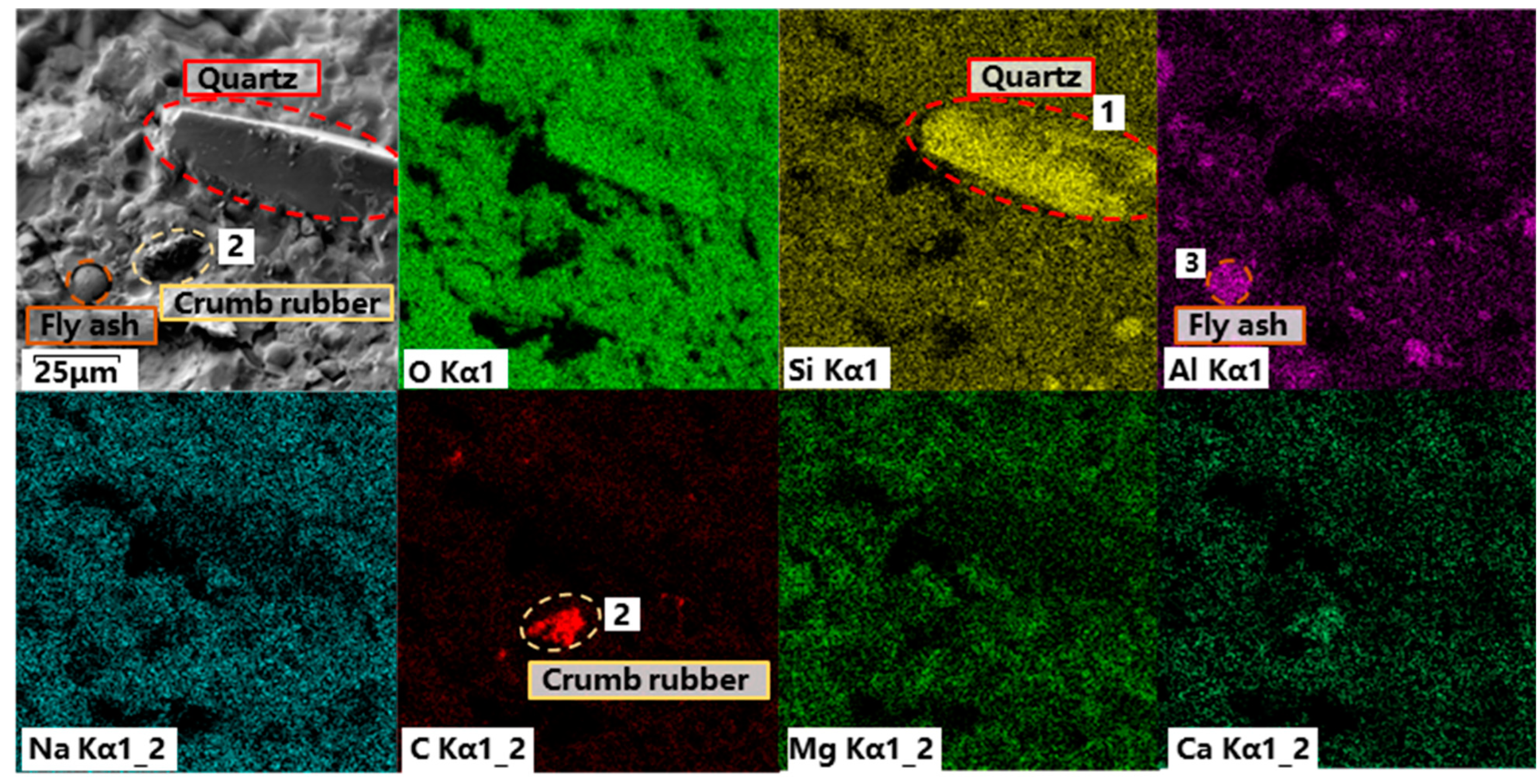
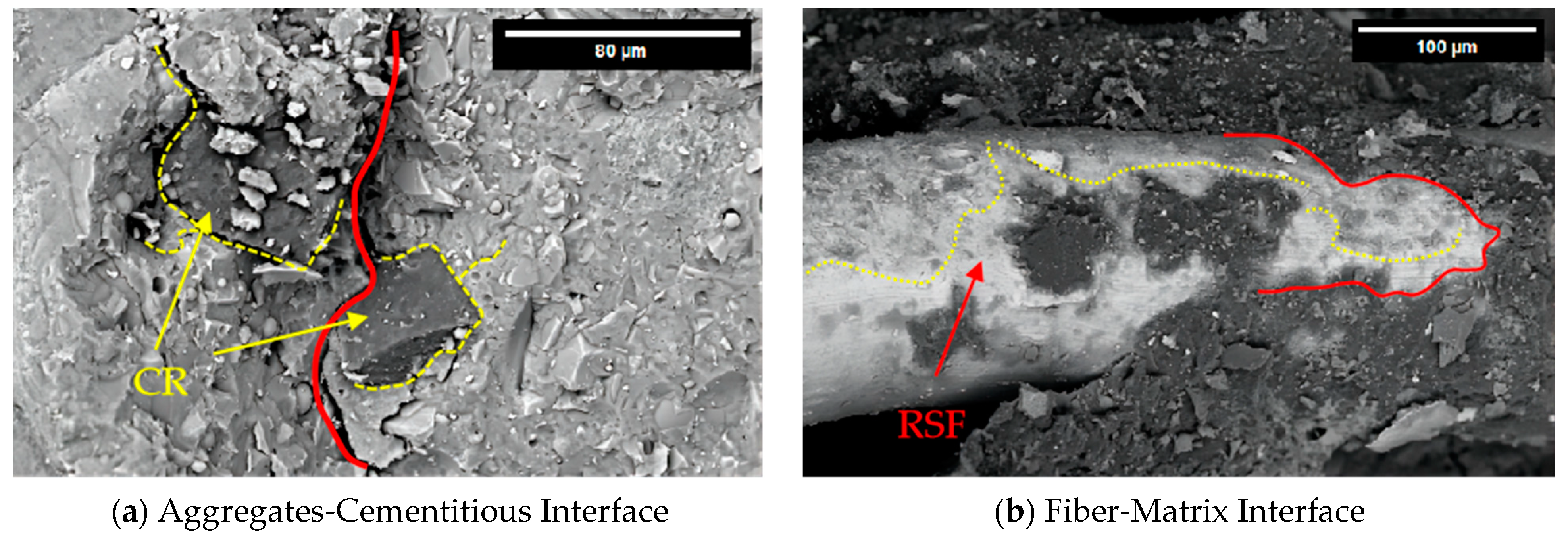

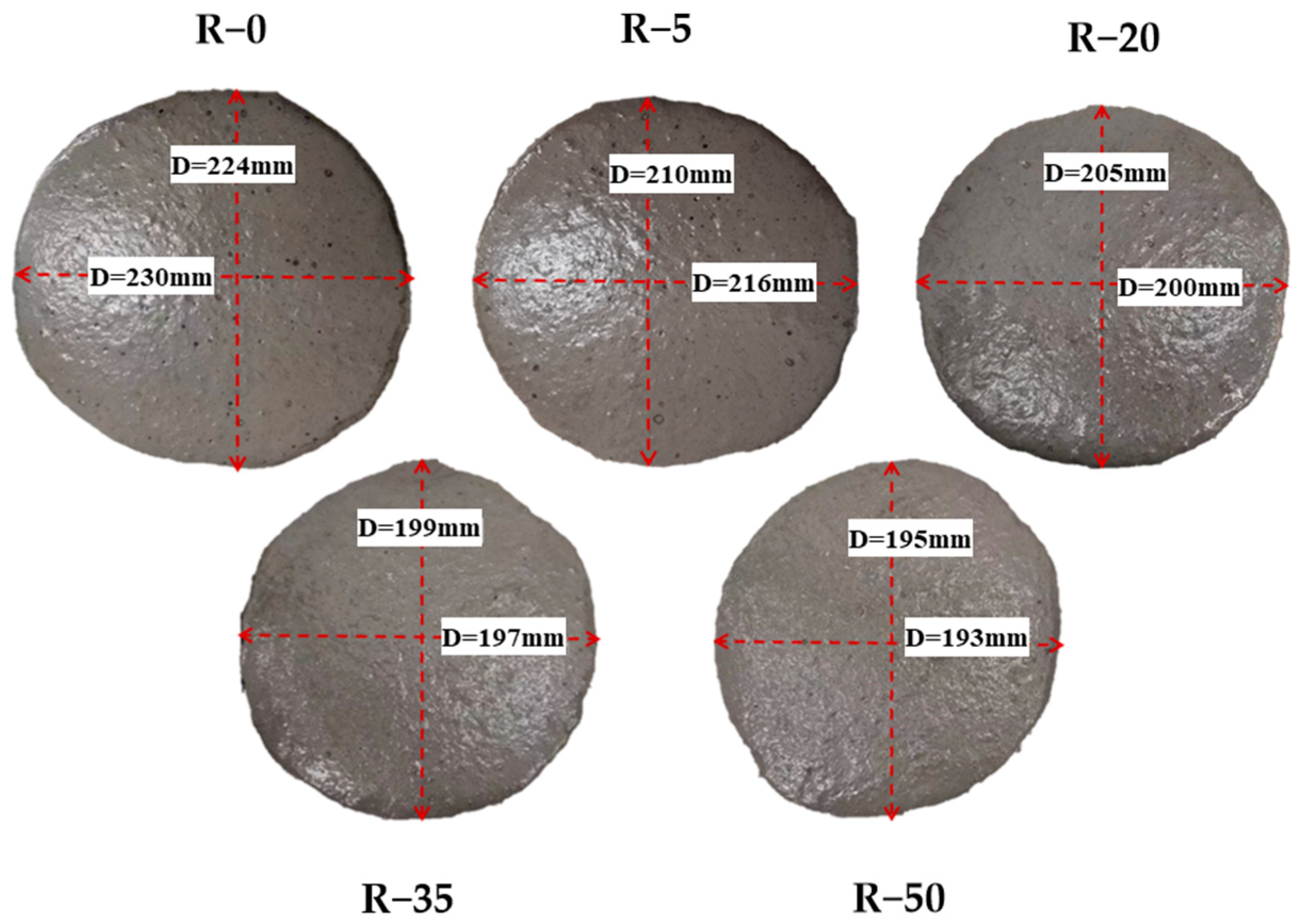
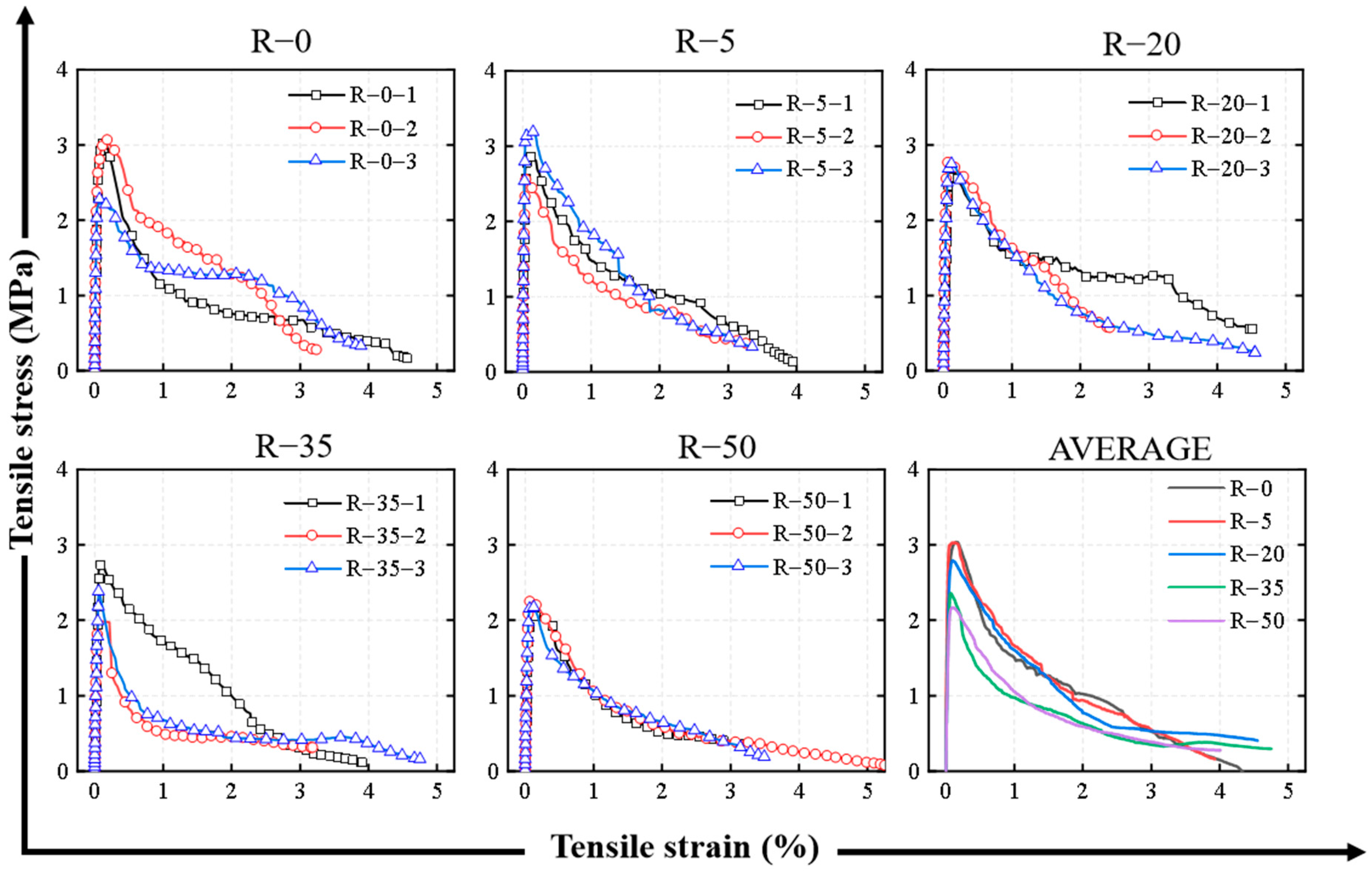


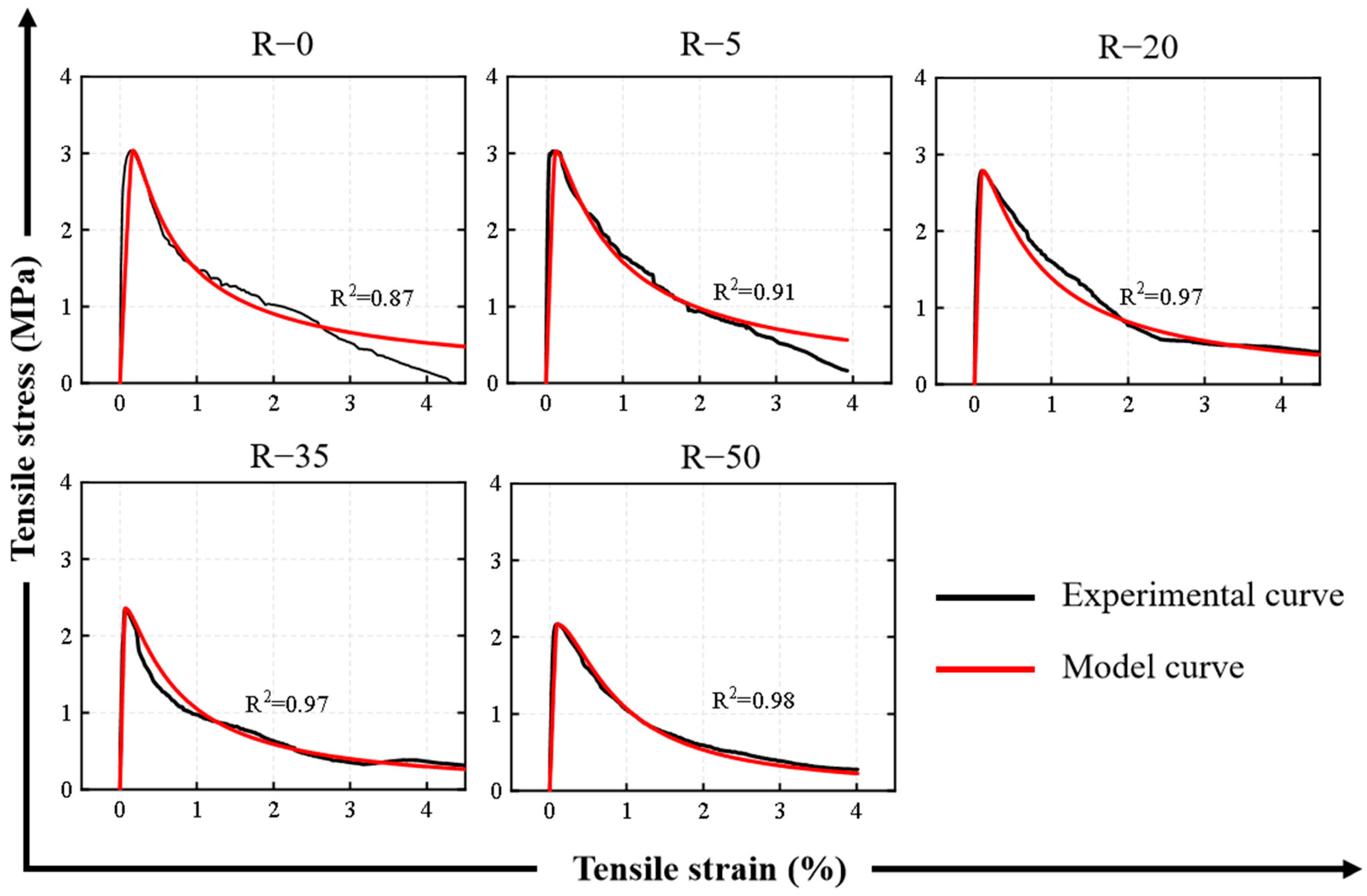
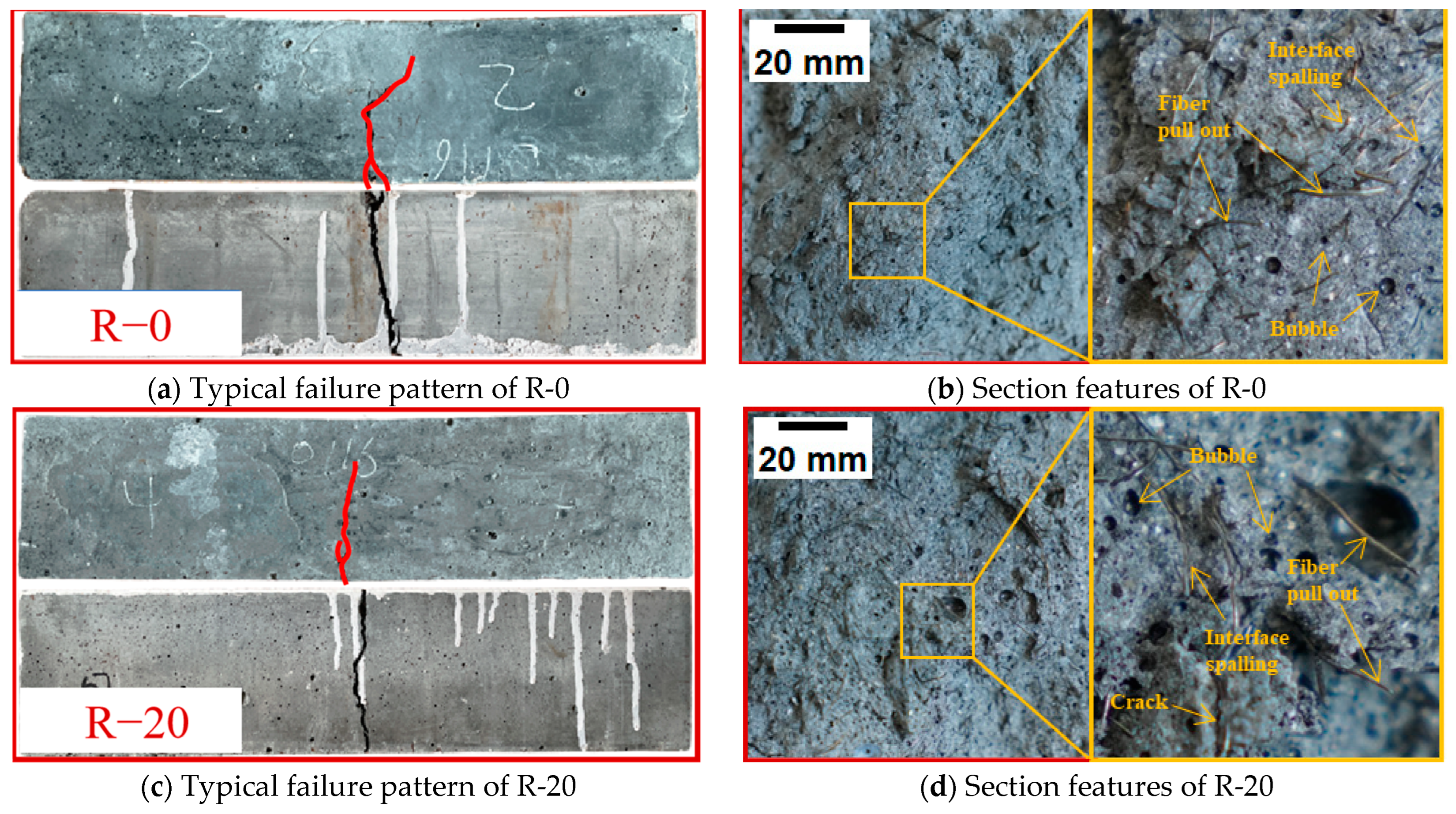

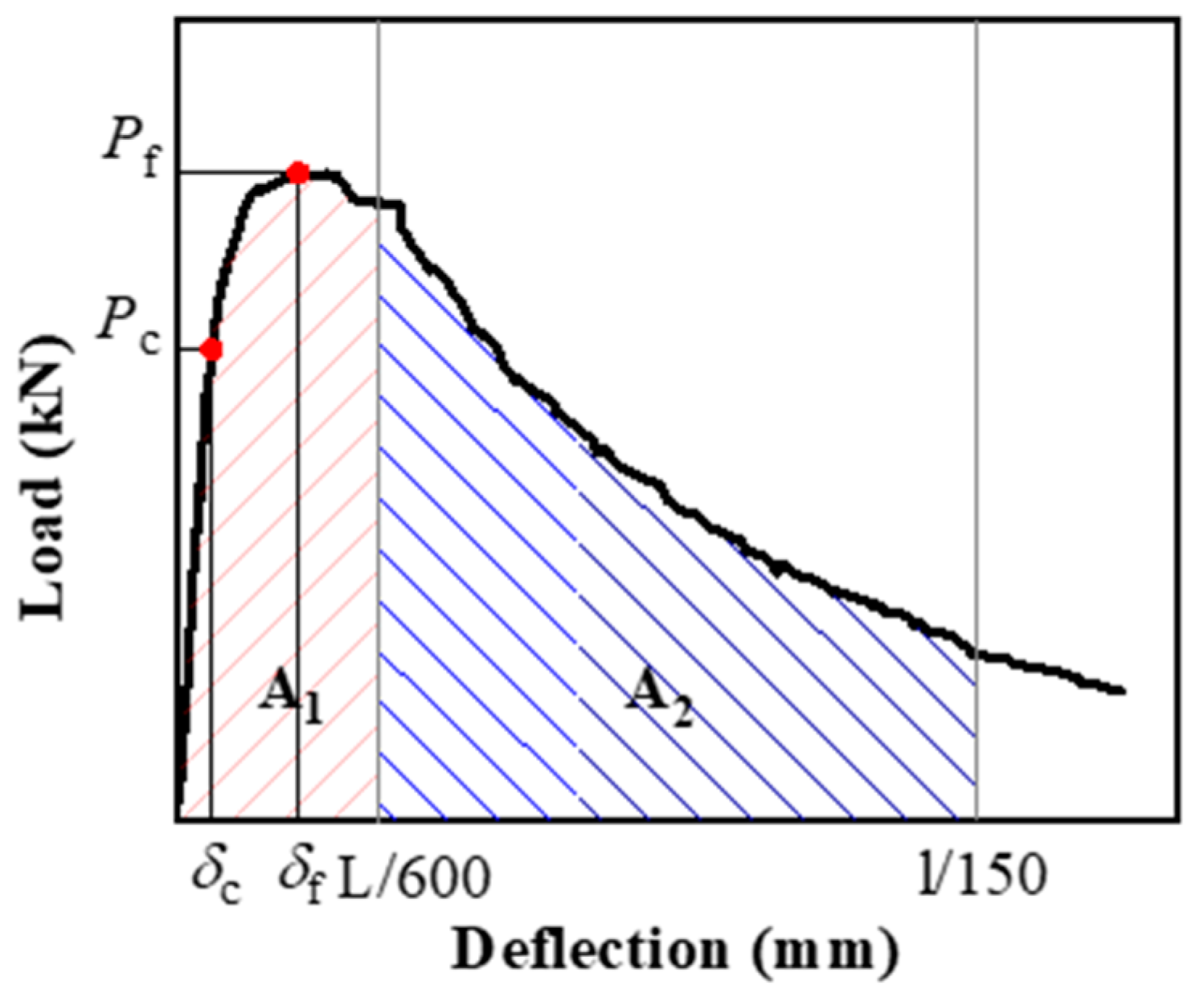
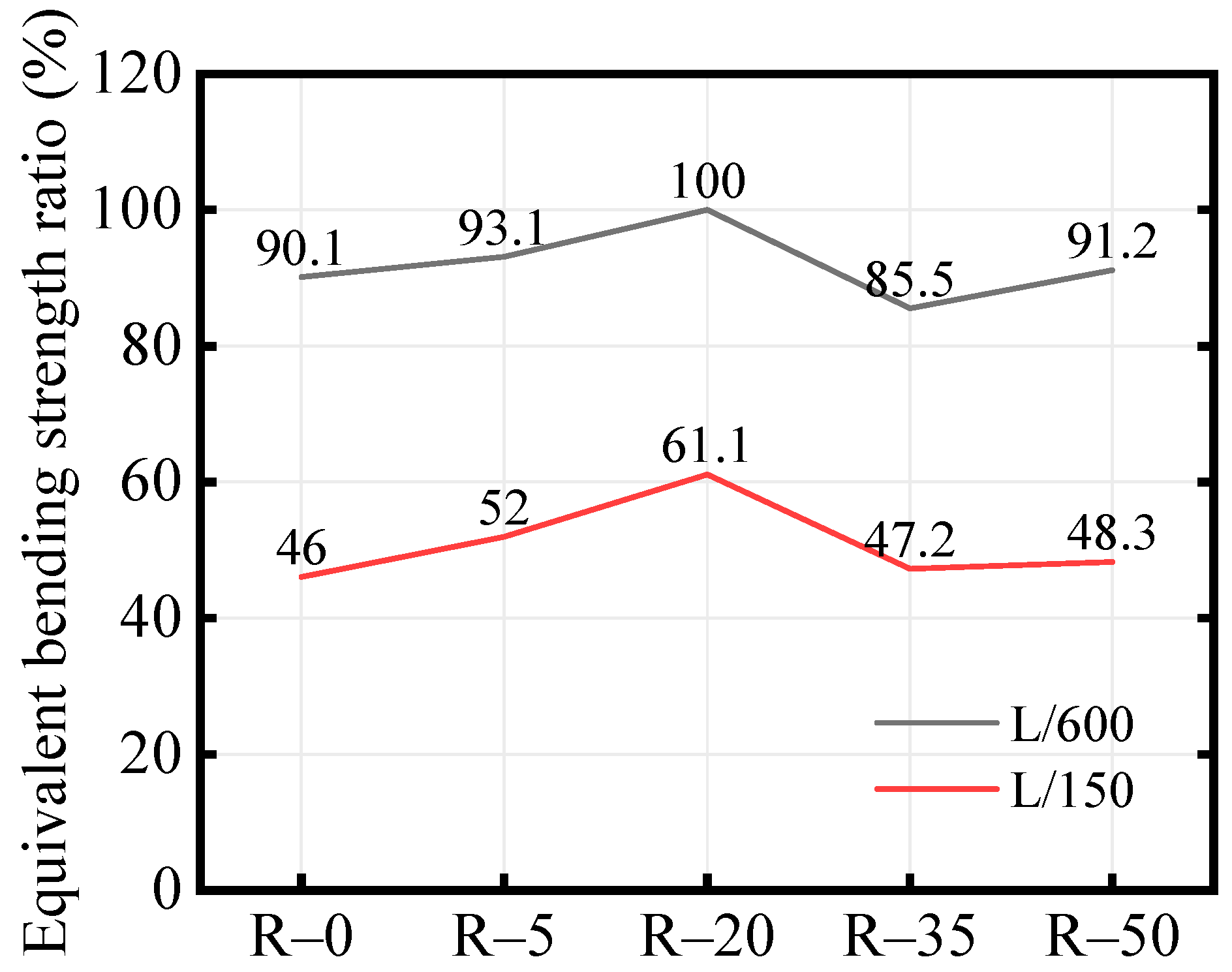
| Oxide | CaO | SiO2 | Al2O3 | SO3 | Fe2O3 | MgO | TiO2 | Other | Loss on Ignition (%) |
|---|---|---|---|---|---|---|---|---|---|
| wt % | |||||||||
| GGBS | 34 | 34.5 | 17.7 | 1.64 | 1.03 | 6.01 | / | 5.12 | 0.84 |
| FA | 4.01 | 53.97 | 31.15 | 2.2 | 4.16 | 1.01 | 1.13 | 2.37 | 4.6 |
| SF | / | 94.7 | / | 0.2 | / | / | / | 5.07 | 1.5 |
| Fibre Type | Length (mm) | Diameter (mm) | Strength (MPa) | Aspect Ratio (L/d) |
|---|---|---|---|---|
| RSF | 9.92 (Mean value) | 0.3 | 2570 | 33.07 |
| Mix | GGBS | FA | SF | NaOH | Sodium Silicate Solution | Extra Water | MS | FS | CR | BaCl2 | RSF | Compressive Strength (MPa) |
|---|---|---|---|---|---|---|---|---|---|---|---|---|
| R-0 | 688 | 167 | 45.0 | 28.5 | 307 | 117 | 543 | 362 | 0.00 | 9.10 | 156 | 148 |
| R-5 | 688 | 167 | 45.0 | 28.5 | 307 | 117 | 516 | 344 | 19.3 | 9.10 | 156 | 137 |
| R-20 | 688 | 167 | 45.0 | 28.5 | 307 | 117 | 434 | 290 | 77.2 | 9.10 | 156 | 105 |
| R-35 | 688 | 167 | 45.0 | 28.5 | 307 | 117 | 353 | 235 | 135 | 9.10 | 156 | 76.6 |
| R-50 | 688 | 167 | 45.0 | 28.5 | 307 | 117 | 272 | 181 | 193 | 9.10 | 156 | 51.3 |
| Mix | Initial Cracking Strength (MPa) | Initial Cracking STRAIN (%) | Peak Strength (MPa) | Strain Capacity (%) | Tensile Modulus (GPa) | Strain Energy (kJ/m3) |
|---|---|---|---|---|---|---|
| R-0 | 2.48 (0.29) | 0.043 (0.009) | 2.79 (0.44) | 0.14 (0.06) | 5.90 (0.80) | 41.40 (7.01) |
| R-5 | 2.72 (0.30) | 0.037 (0.001) | 2.88 (0.31) | 0.10 (0.05) | 7.43 (1.42) | 40.13 (5.43) |
| R-20 | 2.55 (0.08) | 0.056 (0.015) | 2.70 (0.04) | 0.11 (0.06) | 4.57 (1.33) | 41.20 (5.28) |
| R-35 | 2.19 (0.46) | 0.046 (0.015) | 2.38 (0.37) | 0.07 (0.03) | 4.37 (0.32) | 27.53 (11.88) |
| R-50 | 2.03 (0.12) | 0.052 (0.003) | 2.16 (0.11) | 0.13 (0.07) | 3.90 (0.26) | 28.57 (0.85) |
| Mix | Initial Cracking Load (kN) | Initial Cracking Deflection (mm) | Peak Load (kN) | Peak Deflection (mm) | (MPa) | (MPa) | |
|---|---|---|---|---|---|---|---|
| R-0 | 17.5 (2.1) | 0.110 (0.033) | 166 | 20.1 (2.9) | 0.232 (0.083) | 6.99 (0.84) | 8.05 (1.15) |
| R-5 | 18.8 (1.5) | 0.123 (0.059) | 171 | 20.7 (2.7) | 0.259 (0.125) | 7.35 (0.60) | 8.28 (1.07) |
| R-20 | 17.6 (1.4) | 0.125 (0.049) | 150 | 20.8 (0.8) | 0.354 (0.037) | 7.02 (0.57) | 8.33 (0.33) |
| R-35 | 13.0 (1.4) | 0.117 (0.011) | 112 | 14.5 (0.6) | 0.234 (0.067) | 5.18 (0.54) | 5.80 (0.23) |
| R-50 | 12.0 (1.1) | 0.145 (0.021) | 81.0 | 13.2 (1.3) | 0.256 (0.034) | 4.66 (0.44) | 5.29 (0.53) |
| Mix | (J) | (MPa) | (%) | (J) | (MPa) | (%) |
|---|---|---|---|---|---|---|
| R-0 | 10.5 (1.6) | 6.30 | 90.1 | 21.5 (5.7) | 3.23 | 46.0 |
| R-5 | 11.4 (1.4) | 6.84 | 93.1 | 25.5 (8.4) | 3.83 | 52.0 |
| R-20 | 11.7 (0.2) | 7.02 | 100 | 28.6 (5.9) | 4.29 | 61.1 |
| R-35 | 7.38 (0.90) | 4.43 | 85.5 | 16.3 (3.9) | 2.45 | 47.2 |
| R-50 | 7.08 (0.30) | 4.25 | 91.2 | 15.0 (0.4) | 2.25 | 48.3 |
Disclaimer/Publisher’s Note: The statements, opinions and data contained in all publications are solely those of the individual author(s) and contributor(s) and not of MDPI and/or the editor(s). MDPI and/or the editor(s) disclaim responsibility for any injury to people or property resulting from any ideas, methods, instructions or products referred to in the content. |
© 2024 by the authors. Licensee MDPI, Basel, Switzerland. This article is an open access article distributed under the terms and conditions of the Creative Commons Attribution (CC BY) license (https://creativecommons.org/licenses/by/4.0/).
Share and Cite
Li, L.; Chen, Z.; Che, W.; Cheng, C.; Chen, Y.; Li, D.; Liu, L.; Guo, Y. Ultra-High-Performance Alkali-Activated Concrete: Effect of Waste Crumb Rubber Aggregate Proportions on Tensile and Flexural Properties. Buildings 2024, 14, 1088. https://doi.org/10.3390/buildings14041088
Li L, Chen Z, Che W, Cheng C, Chen Y, Li D, Liu L, Guo Y. Ultra-High-Performance Alkali-Activated Concrete: Effect of Waste Crumb Rubber Aggregate Proportions on Tensile and Flexural Properties. Buildings. 2024; 14(4):1088. https://doi.org/10.3390/buildings14041088
Chicago/Turabian StyleLi, Lei, Zhongmin Chen, Weixian Che, Cheng Cheng, Yiwu Chen, Dehui Li, Lianghua Liu, and Yongchang Guo. 2024. "Ultra-High-Performance Alkali-Activated Concrete: Effect of Waste Crumb Rubber Aggregate Proportions on Tensile and Flexural Properties" Buildings 14, no. 4: 1088. https://doi.org/10.3390/buildings14041088




